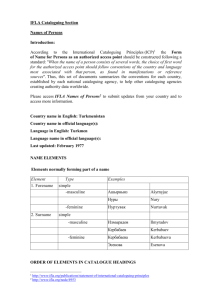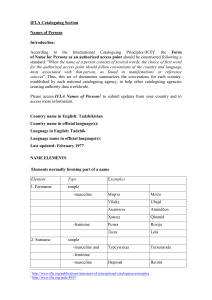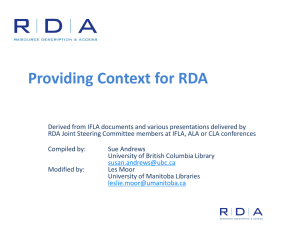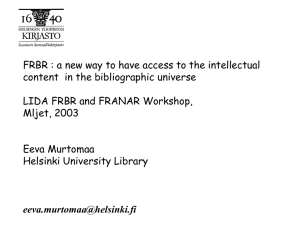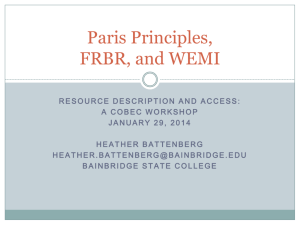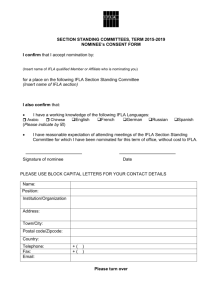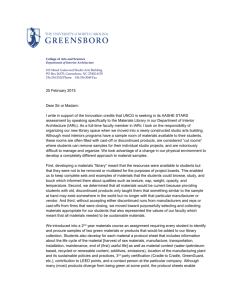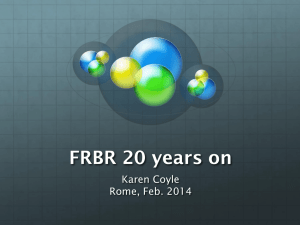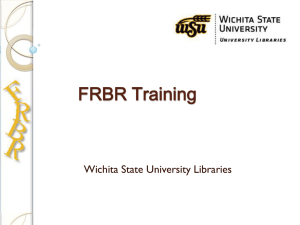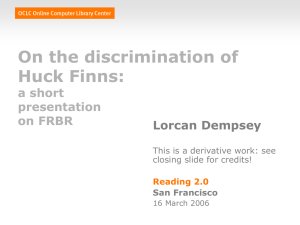AACR2's Strategic Plan and IFLA Work towards an
advertisement
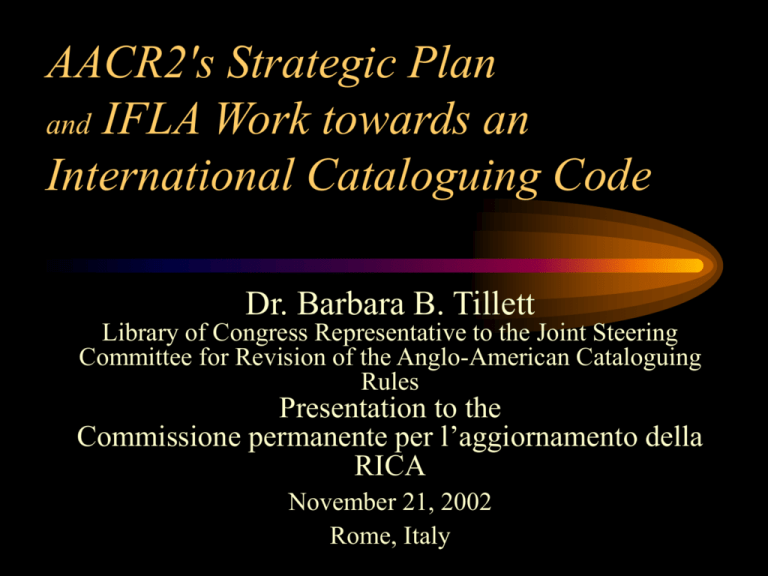
AACR2's Strategic Plan and IFLA Work towards an International Cataloguing Code Dr. Barbara B. Tillett Library of Congress Representative to the Joint Steering Committee for Revision of the Anglo-American Cataloguing Rules Presentation to the Commissione permanente per l’aggiornamento della RICA November 21, 2002 Rome, Italy History of AACR • • • • Panizzi – British Museum – 91 rules (1841) Cutter – Rules for a dictionary catalog (1876) Paris Principles (1961) AACR (1967) – North American ed. – British ed. • ISBD (1969+) • AACR2 (1978) AACR2 • AACR2 (1978, 1988, 1998, 2002) AACR Used Worldwide • Basis of the majority of records in machinereadable form – Over 48 million in OCLC – Worldwide publication coverage AACR2, 2002 Revision • • • • Now available Loose-leaf Binder with tabs Annual updates LC Actions to Implement AACR Changes • Implementation of the 2002 Revision effective December 1, 2002 • Distribution of updates – LCRIs for internal consistency of rule application – Cataloger’s Desktop Descriptive and Access Elements • Description – ISBD areas • • • • • • • • 1 2 3 4 5 6 7 8 • Access title and statement of responsibility edition material specific details publication, distribution, etc. physical description series notes standard numbers and terms of availability – Controlled vocabularies, syndetic structure of references – Classification, call numbers, standard numbers, barcodes – Direct links Structure of the Rules Part I - Description • Chapter 1 – General rules • Chapter 2-12 – Classes of material • • • • • • • • • • • Books, Pamphlets, and Printed Sheets Cartographic Materials Manuscripts Music Sound Recordings Motion Pictures and Videorecordings Graphic Materials Electronic Resources Three-dimensional Artefacts and Realia Microforms Serials • Chapter 13 - Analysis Part II – Choice and Form of Access Points • Chapter 21 – Choice of Access Points • Chapter 22-25 – Headings – – – – Persons Geographic Names Corporate Bodies Uniform Titles • Chapter 26 - References Appendices • • • • • Capitalization Abbreviations Numerals Initial Articles Glossary • Index JSC Meeting - Sept. 9-11, 2002 York, England • FRBR terminology – So rules will be more precise • Format Variation Working Group – Expression-level citations – OPAC displays for collocation • Work level • Expression level (versions, translations, performances, etc.) • Manifestation level JSC Meeting - Sept. 9-11, 2002 York, England • SMD (Special Material designators) • Ch. 9 - Electronic Resources – Class of materials (computer files, software, etc.) vs.. – “Carrier” or “container” - “digital” as a type of manifestation • Area 8 Standard Numbers --> Area 7 Notes Strategic Plan for AACR • AACR is a multinational code for bibliographic description and access • For all media • Developed for use in English-language communities • Independent of communication format • Rules constantly evolve to meet changing needs • Allow for different levels of description • Assure consistency of practice for shared cataloguing • Enable search precision through controlled forms of access points Target 1 New edition (AACR3) • 2005 (2007 or 2008?) • For Web-environment • Compatible with international efforts • New Introductions – Cataloging principles and concepts for description and access • FRBR terminology and concepts – Work, Expression, Manifestation, Item • Revise ambiguous and inconsistent terms – main entry, added entry, entry • Authority control concepts • Class of materials & GMD problems to be resolved Objectives of the Catalog User Tasks • Find – Locate a single resource – Collocate all resources at various levels • Gathering together all works of an author (by author’s name, title, subject, etc.) • • • • Identify Select Obtain Navigate Principles of Bibliographic Description and Access • • • • • • • • • User convenience Common usage Representation Accuracy Sufficiency and necessity Brevity and clarity Standardization Integration Independent of format Target 2 Outreach to other communities • Build relationships with other groups – ISBD Review Group communications – Rule-making bodies worldwide • Participation in key conferences and meetings: – IFLA meeting of experts (1st : Frankfurt, 2003) – Dublin Core, VRA, DOI, MARBI, etc. • Publicize “Strategic Plan” – JSC Web site: http://www.nlc-bnc.ca/jsc/ Target 3 Add a Web-based version of rules • Identify issues with AACR publishers in 2002-2003 • Resolve issues arising from advice and comments on requirements, functionality, etc. • Co-publishers will conduct market research in 2003 FRBR Impact on Cataloging Rules • • • • Conceptual model of bibliographic universe New vocabulary Clarifies concepts Renews focus on the objectives of a catalog – Collocation of works and expressions • Reinforces importance of controlled access – Relationships among bibliographic resources and agents Work is realized through Expression Intellectual/ artistic content Physical recording of content Manifestation Item is embodied in is exemplified by FRBR Entity Levels Expression: The Movie The Novel Work: Orig. Text Transl. Critical Edition Orig. Version Manifestation: Paper PDF HTML FRBR Entity Levels Family of works The Movie The Novel Work: Expression: Orig. Text Transl. Critical Edition Orig. Version Manifestation: Paper Item: Copy 1 Autographed PDF Copy 2 HTML Applications • OCLC Research (to be published) – ~20% of works have more than 1 manifestation • Classics of literature vs. scientific studies • Examples in the OCLC database – Shakespeare’s Hamlet • 1 work, 2696 manifestations – Rowling, J.K. (Harry Potter stories) • 28 works, 300 manifestations Collocation by Expressions • Shakespeare, William, 1564-1616. Hamlet. – – – – – – Books – Danish Books – Dutch Books – English Books – French Books – Spanish Motion Pictures – English Collocation by Expressions • J.S. Bach’s Goldberg variations – Performances: Glen Gould (1981) – Scores IFLA Work – International Cataloguing Code • 1960’s meetings of experts – Paris 1961 Paris Principles (access) • (International Conference on Cataloguing Principles) – Copenhagen 1969 ISBDs (description) • (International Meeting of Cataloging Experts) • Changes – Online/Web catalogs, machine-readable records – FRBR concepts (1998) – Electronic and future “carriers” for information IFLA Activities • IFLA Meeting of Experts on an International Cataloguing Code – 2003, Frankfurt (European codes) – 2004, Buenos Aires (Central America, South America) – 2006, Seoul, Korea (Asian codes) IFLA Meeting of Experts 2003 • Goals: • Objective: increase ability to share cataloguing worldwide Promote content standards for bibliographic and authority records Get our codes closer together – Examine European cataloguing codes • Similarities • Differences – Why different (cultural variations?) IFLA Meeting of Experts 2003 • Commissioned papers on Web – Discussion within countries and shared globally (April-June 2003) • Presentations and working groups in Frankfurt (July 2003) – Limited to 50-60 participants – invitation only • Focus topics: – – – – Names of persons Names of corporate bodies Uniform titles / GMDs Seriality / when to make a new record – Multilevel cataloging of multiple works in multiple volumes – Paris Principles: main and added entries IFLA Meeting of Experts 2003 IFL A
